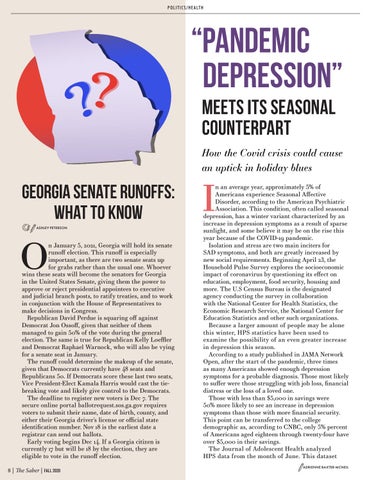P O L I T I C S / H E A LT H
“Pandemic depression” meets its seasonal counterpart How the Covid crisis could cause an uptick in holiday blues
Georgia Senate Runoffs: What to know ASHLEY PETERSON
O
n January 5, 2021, Georgia will hold its senate runoff election. This runoff is especially important, as there are two senate seats up for grabs rather than the usual one. Whoever wins these seats will become the senators for Georgia in the United States Senate, giving them the power to approve or reject presidential appointees to executive and judicial branch posts, to ratify treaties, and to work in conjunction with the House of Representatives to make decisions in Congress. Republican David Perdue is squaring off against Democrat Jon Ossoff, given that neither of them managed to gain 50% of the vote during the general election. The same is true for Republican Kelly Loeffler and Democrat Raphael Warnock, who will also be vying for a senate seat in January. The runoff could determine the makeup of the senate, given that Democrats currently have 48 seats and Republicans 50. If Democrats score these last two seats, Vice President-Elect Kamala Harris would cast the tiebreaking vote and likely give control to the Democrats. The deadline to register new voters is Dec 7. The secure online portal ballotrequest.sos.ga.gov requires voters to submit their name, date of birth, county, and either their Georgia driver’s license or official state identification number. Nov 18 is the earliest date a registrar can send out ballots. Early voting begins Dec 14. If a Georgia citizen is currently 17 but will be 18 by the election, they are eligible to vote in the runoff election.
8 | The Saber | FALL 2020
I
n an average year, approximately 5% of Americans experience Seasonal Affective Disorder, according to the American Psychiatric Association. This condition, often called seasonal depression, has a winter variant characterized by an increase in depression symptoms as a result of sparse sunlight, and some believe it may be on the rise this year because of the COVID-19 pandemic. Isolation and stress are two main inciters for SAD symptoms, and both are greatly increased by new social requirements. Beginning April 23, the Household Pulse Survey explores the socioeconomic impact of coronavirus by questioning its effect on education, employment, food security, housing and more. The U.S Census Bureau is the designated agency conducting the survey in collaboration with the National Center for Health Statistics, the Economic Research Service, the National Center for Education Statistics and other such organizations. Because a larger amount of people may be alone this winter, HPS statistics have been used to examine the possibility of an even greater increase in depression this season. According to a study published in JAMA Network Open, after the start of the pandemic, three times as many Americans showed enough depression symptoms for a probable diagnosis. Those most likely to suffer were those struggling with job loss, financial distress or the loss of a loved one. Those with less than $5,000 in savings were 50% more likely to see an increase in depression symptoms than those with more financial security. This point can be transferred to the college demographic as, according to CNBC, only 5% percent of Americans aged eighteen through twenty-four have over $5,000 in their savings. The Journal of Adolescent Health analyzed HPS data from the month of June. This dataset ADRIENNE BAXTER-MCNEIL
